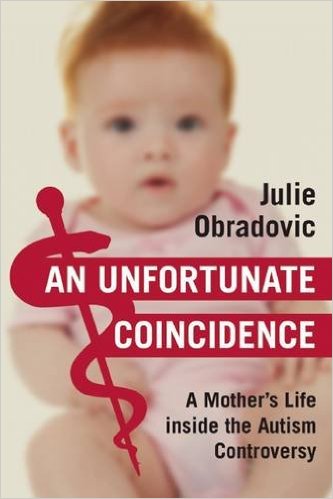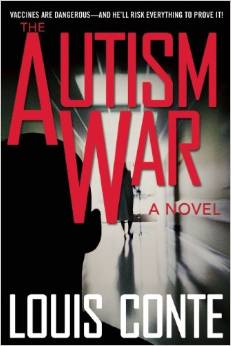October 31, 2016
 Pray, don’t find fault with the man that limps,
Pray, don’t find fault with the man that limps,
Or stumbles along the road.
Unless you have worn the moccasins he wears,
Or stumbled beneath the same load.
. . . Take the time to walk a mile in his moccasins.
– Judge Softly, by Mary T. Lathrop (1895)
So truly, not much has changed in the almost eighty years since Kanner’s first wrong turn. Moms are still the problem. Moms are still the cause. And moms are still to blame.
“You caused a mental condition in your child,” the medical community has claimed about mothers for over seven decades.
“No, you caused a medical one,” mothers have finally fired back at them.
For the first time since the discovery of autism, mothers have turned the tables. They weren’t the ones to cause their child’s autism, they realized, especially as the numbers of them sharing their stories exploded, doctors were. And for the first time, doctors were going to see what it felt like to be on the receiving end of such a strong accusation.
It’s fair to say, they don’t like it either.
– Excerpt from An Unfortunate Coincidence
Julie Obradovic’s new book, An Unfortunate Coincidence: A Mother’s Life inside the Autism Controversy, comes out tomorrow. I’ve been looking forward to this one ever since I heard that Julie was writing it, and I’m happy to say it doesn’t disappoint.
 One of our more important goals here at TMR is providing a safe place where parents of kids with autism (particularly severe autism) can find community and help dealing with all the difficult aspects of their lives, but especially anything related to their children’s health. That goal puts us in frequent – sometimes heartbreaking — contact with people who need help, but it also puts us in contact with those who can help them. One of the joys of our job is meeting “old-timers” who have been on the front lines of autism awareness and advocacy and are still out there helping newcomers even if their own children have recovered from autism. One such old-timer is Julie Obradovic, whose new book, An Unfortunate Coincidence, is about her journey since the birth of her daughter Emma in 2001 who, like so many children these days, was born neurotypical and yet was diagnosed with autism at the age of three. Like so many others, Julie’s child was a victim of “unfortunate coincidence” when she went from being a happy, healthy child to a very sick child – with an eventual autism diagnosis – due to repeated rounds of vaccines while on repeated rounds of antibiotics.
One of our more important goals here at TMR is providing a safe place where parents of kids with autism (particularly severe autism) can find community and help dealing with all the difficult aspects of their lives, but especially anything related to their children’s health. That goal puts us in frequent – sometimes heartbreaking — contact with people who need help, but it also puts us in contact with those who can help them. One of the joys of our job is meeting “old-timers” who have been on the front lines of autism awareness and advocacy and are still out there helping newcomers even if their own children have recovered from autism. One such old-timer is Julie Obradovic, whose new book, An Unfortunate Coincidence, is about her journey since the birth of her daughter Emma in 2001 who, like so many children these days, was born neurotypical and yet was diagnosed with autism at the age of three. Like so many others, Julie’s child was a victim of “unfortunate coincidence” when she went from being a happy, healthy child to a very sick child – with an eventual autism diagnosis – due to repeated rounds of vaccines while on repeated rounds of antibiotics.
In the past decade, I’ve read or heard thousands of these stories, and quite a few have made it to print, many of them in our very own TMR books, Thinking Moms’ Revolution: Autism Beyond the Spectrum and TEAM TMR: Evolution of a Revolution or our blog.
So what makes this one special?
Two things: First, Obradovic has a rare way with words. Those words have the power to draw you into her experience and make you see it from her eyes in a way that is rivaled by few. In other words, as Mary T. Lathrop advised in 1895, she can help you walk a metaphorical mile in her moccasins. With autism as common as it is these days, that is an extremely valuable skill. So many people identify with Julie’s description of her and her daughter’s journey that every time we run one of the blogs she’s written, we have to be mindful of our server capacity. At least two of them have gone viral to the point that they actually reached thousands of people outside the autism community, and one of them literally brought down our website. In fact, in combination with Tetyana Obukhanych’s “Open Letter to Legislators Currently Considering Vaccine Legislation,” which ran shortly thereafter, it was instrumental in forcing us to upgrade our service.
As Obradovic describes the early days of her marriage and motherhood, it is clear that she saw her life as “normal” and perhaps even “ordinary” until the cycle of illnesses began with Emma, her second child. Julie and her husband Mike were not long out of college when she got pregnant with their first child. They got married, bought a house, and she began her career as a Spanish teacher. They planned on having a total of five children, and living near both sets of grandparents; it seemed a doable ambition. Until, that is, it became clear that Emma’s health was going to be of such concern that it would derail or threaten to derail, not only Julie’s promising teaching career, but Julie and Mike’s life plans, their finances, and eventually even their marriage as well.
There is no mother alive, at least not one who is deserving of the term, who will not empathize with Obradovic’s concern about Emma’s failing health, especially the harrowing incident that occurred following a round of vaccines. The Obradovics came home to Julie’s extremely worried aunt describing a cry she had never heard before coming from the infant Emma – a high-pitched cry accompanied by severe back arching that has come to be known as the “encephalitic cry” and is hauntingly familiar to many traumatized parents of children who were later diagnosed with autism or another neurological disorder. (I know many people who will experience PTSD flashbacks reading this chapter, so consider this a trigger warning. In addition, Emma’s health history includes repeated extreme ear infections, gastrointestinal distress, seizures, and a terrifying wandering episode.)
The second thing that makes this a book you really shouldn’t miss is the fact that Julie, unlike most, had a ringside seat for much of the last decade of the bloody fight that Louis Conte dubbed “The Autism War” in his book of the same name. Before her daughter was diagnosed, and despite the fact that she was a teacher, Obradovic had so little awareness of autism that she had no idea that her daughter had autism until she had already seen a number of therapists and doctors looking for answers. By 2015, however, she was among the very visible vaccine safety and health choice advocates to feel the waves of media-inspired hatred sparked by the 111 cases of measles that began in Disneyland.
 As readers, we accompany Obradovic and feel her bewilderment as she troops from doctor to doctor in search of help for her obviously sick child and her frustration as she is repeatedly patronized, given bad medical advice, and dismissed. When she finally has an inkling that Emma has autism and takes her to a neurologist, hoping that at last she will receive a plan to help her child get well, those hopes are unceremoniously dashed. Like so many mothers since Leo Kanner first described and named the syndrome in the 1940s – and came up with the term “refrigerator parent” to explain its genesis – along with the autism diagnosis, Julie received the message that it was her fault her child was this way. Instead of providing the anticipated plan, the neurologist handed her a prescription for a psychologist who could help her “deal with her disappointment” in her daughter. The doctor didn’t go quite so far as to say she had caused her child’s condition, but he certainly did seem to be implying it was Julie’s fault that her daughter was so far behind her peers.
As readers, we accompany Obradovic and feel her bewilderment as she troops from doctor to doctor in search of help for her obviously sick child and her frustration as she is repeatedly patronized, given bad medical advice, and dismissed. When she finally has an inkling that Emma has autism and takes her to a neurologist, hoping that at last she will receive a plan to help her child get well, those hopes are unceremoniously dashed. Like so many mothers since Leo Kanner first described and named the syndrome in the 1940s – and came up with the term “refrigerator parent” to explain its genesis – along with the autism diagnosis, Julie received the message that it was her fault her child was this way. Instead of providing the anticipated plan, the neurologist handed her a prescription for a psychologist who could help her “deal with her disappointment” in her daughter. The doctor didn’t go quite so far as to say she had caused her child’s condition, but he certainly did seem to be implying it was Julie’s fault that her daughter was so far behind her peers.
Fortunately for Emma, it was the age of the Internet. After it became crystal clear that she wasn’t going to get the help Emma required from the medical doctors that she had trusted so implicitly, Obradovic found – again, like so many others – that it was other parents who could and would give her real information she could act on that just might help her child. She connected with these parents on Internet message boards and participated in long email threads with many of the biomedical vanguard. She started using digestive enzymes, probiotics, and nutritional supplements that turned Emma’s health around rapidly in a way that no doctor had ever implied was possible. Obradovic was hooked. As the mother of a child with apraxia who began talking much more shortly after beginning a similar program of supplements, I completely identified with her reliance on other parents and her turn toward medical activism and advocacy.
It was her trust in these parents who had been of such help to her daughter that eventually forced Obradovic to come to terms with the vaccine question. She initially resisted the idea that vaccines could be implicated in her daughter’s illness and autism, especially after the Institute of Medicine essentially absolved them of all role in the recent sharp rise in autism diagnoses in 2004. For a long time, she would delete the emails from parents who kept bringing up the topic. Eventually though, Julie realized that knowledgeable parents are just that, knowledgeable. As she says, “It was always moms pointing me in the right direction.” Those moms didn’t suddenly become nuts simply because the topic was one that is uncomfortable and difficult to resolve with the mainstream view. When she heard that the Eli Lilly rider, absolving the manufacturer of Thimerosal of all monetary responsibility for harm done by its product, was tacked onto the Homeland Security Act the night before its guaranteed passage in 2002, Obradovic finally decided it was time to investigate. And what she discovered was horrifying to say the least.

The author, Julie Obradovic
As a mom, Obradovic consulted with the legendary Dr. Bernard Rimland, author of Infantile Autism: The Syndrome and Its Implications for a Neural Theory of Behavior, and the person most responsible for the ending the “refrigerator mother” concept, and as a result, Emma progressed so rapidly that she no longer qualified for early intervention. (As Obradovic points out, this rapid improvement should be compelling evidence that her daughter’s condition was indeed at least partially caused by her vaccines, as treatments to reverse the damage dramatically improved her physical and mental health.)
As an activist and advocate, Obradovic was there in 2005 when journalist David Kirby (author of Death at SeaWorld) wrote Evidence of Harm: Mercury in Vaccines and the Autism Epidemic: A Medical Controversy, based upon information originally gathered by the group known as the “Mercury Moms,” including Sallie Bernard (board member of SafeMinds and Autism Speaks), Lyn Redwood (long-term member of the Interagency Autism Coordinating Committee and SafeMinds board member), and the late Elizabeth Birt (for whom the Elizabeth Birth Center for Autism Law and Advocacy – “EBCALA”—was named). Shortly after the book’s publication, Obradovic became an outspoken critic of the CDC and U.S. vaccine policy, writing essays and flying to Washington for a rally, and in early 2007, she hosted a fundraiser where she had Kirby speak.
She was there when JB Handley began Generation Rescue and Bob and Suzanne Wright started Autism Speaks. She was there when another journalist, Yale-educated Dan Olmsted collaborated with Harvard-and-Princeton-educated autism dad Mark Blaxill in tracking down as many of Leo Kanner’s original 11 autism patients as they could and writing The Age of Autism: Mercury, Medicine, and a Man-Made Epidemic. She was there when they began their website of the same name and became a contributing editor.
She was there when the Combating Autism Act was passed in 2006, and there when Thomas Insel, the former chairman of the Interagency Autism Coordinating Committee (IACC) actually attended an autism conference and gave a speech that demonstrated his profound disconnect with the autism community as he proudly suggested that the solution to the rising autism rates lay in a “vaccine for autism.”
She was there when Jenny McCarthy became a lightning rod for hatred by daring to speak about her son’s experiences with vaccine injury and autism on several major television shows.
She was there when the Omnibus Autism Proceeding’s test cases were decided, and there when David Kirby discovered that one case of autism that had quietly disappeared from the proceeding, that of Hannah Poling, whose parents were a neurologist and a nurse/lawyer, had been conceded by the Department of Health and Human Services – meaning that HHS admitted that vaccines had caused Hannah’s condition, which included autism. HHS tried very hard to keep anyone from hearing about it at all, but when the news came out they tried to spin it as “very rare,” due to an “underlying condition,” and that Hannah had “features of autism” rather than “autism.” No one in the autism community was fooled. Autism is defined by those very “features,” and Hannah’s story was just like theirs, except for the neurologist and lawyer documenting the situation along the way.
Obradovic was there at the 2008 “Green Our Vaccines” rally in Washington with Jenny McCarthy, Jim Carrey, and Robert F. Kennedy, Jr. It was there she first noticed Eric Gladen, a documentary filmmaker who was there due to his own experience of vaccine injury and mercury poisoning as an adult. In 2014, Gladen approached her to help him market his terrific film Trace Amounts. She was instrumental in getting it publicized, shown, and seen with Robert F. Kennedy and panels of local experts. When the 2015 measles outbreak got ugly, and anti-vaccine-exemption legislation started popping up everywhere, including her home state of Illinois, she and Laura Cellini came up with the idea of having a screening for local politicians of the film with Gladen and Kennedy. Obradovic attended a dinner with Kennedy — the Democrat version of royalty — and a local group of Democrat legislators. One of the more entertaining scenes in the book is Obradovic’s musings on driving Kennedy around in her stained minivan, having to tell him to “buckle up.” Later, she would accept a job as Mr. Kennedy’s vaccine-savvy assistant when his activities in this arena increased.
In short, Obradovic’s book offers a much-needed, eloquent, and clear-eyed view of the history of the autism epidemic from someone who lived it, someone accessible and intelligent, and someone who really wished she could trust those in authority — from pediatricians to government agencies and representatives — but has found out the hard way that she really can’t.
By the end of the book, you too will know, as she does, that it’s always moms pointing you in the right direction.
~ Professor
For more by Professor, click here.
For a list of Julie Obradovic’s blogs on TMR, click here.

















Yes, super book! I got my pre-order Fri and couldn’t put it down.